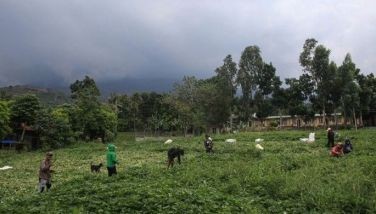Metro sizzles at 36.4ºC
MANILA, Philippines - Metro Manila sizzled at 36.4 degrees Celsius yesterday, the hottest recorded since January, the state weather bureau said.
The temperature was recorded at about 3 p.m. at the Philippine Atmospheric, Geophysical and Astronomical Services Administration (PAGASA)’s station in Quezon City.
Earlier, the weather bureau warned of warmer weather this month.
Based on PAGASA records, the country’s hottest recorded temperature was 42.2 degrees Celsius in Tuguegarao City on May 11, 1969.
On May 14, 1987, Metro Manila was hottest at 38.5 degrees Celsius.
The agency advised the public to brace for frequent occurrences of thunderstorms this month due to warm air.
“We can expect warm weather in the morning and localized thunderstorms in the afternoon or evening,†weather forecaster Aldzar Aurelio said.
No tropical cyclone is expected to develop within and outside the Philippine area of responsibility in the next seven days.
As this developed, the state weather bureau warned of El Niño phenomenon in June that is expected to trigger drought and stronger storms.
PAGASA said El Niño is characterized by below normal rainfall.
Secretary Mario Montejo of the Department of Science and Technology (DOST) said the dry spell is “almost certain,†although he could not confirm yet how intense.
PAGASA is an attached agency of the DOST.
“The El Niño could affect the normal rainfall pattern of the country, resulting in reduced rainfall,†Montejo said.
He said the abnormal weather pattern could also cause tropical cyclones to be erratic, affecting their track and intensity.
“Tropical cyclone tracks are expected to shift northward and intensity could become stronger,†Montejo said, noting Tropical Storm Ondoy and Typhoon Milenyo struck as the country was experiencing El Niño in 2009-2010 and 2006-2007, respectively.
Ondoy inundated several parts of Metro Manila and nearby areas on Sept. 26, 2009.
Milenyo pummeled Luzon, including Metro Manila and the Bicol region, with torrential rains and strong winds on Sept. 28, 2006.
PAGASA deputy administrator for research and development Flaviana Hilario said the increased temperature in the Pacific Ocean during El Niño intensifies weather disturbances such as storms and typhoons.
Montejo said the sea surface temperature anomaly remained neutral during the past several months.
PAGASA noted significant increase in the sea surface temperature from 0.2 to 0.4 degrees Celsius from April 21 to 28.
The established threshold of sea surface temperature anomaly for an El Niño phenomenon is 0.5 degrees Celsius or higher during a three-month period.
“Because of this development and as climate models predict, this condition may persist for the next nine months,†Montejo said.
He said PAGASA foresees the start of the El Niño season in June that might peak during the last quarter of the year until the first quarter of 2015.
- Latest
- Trending





























